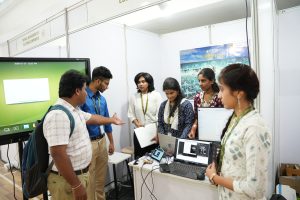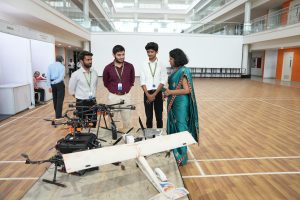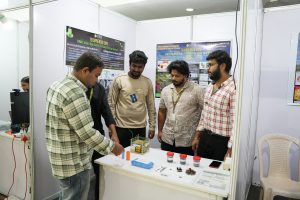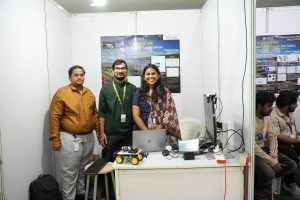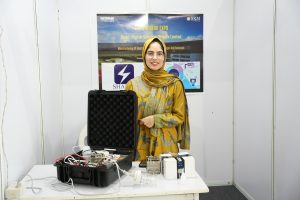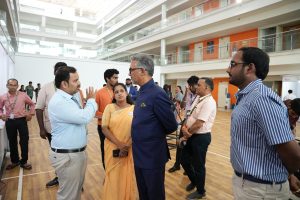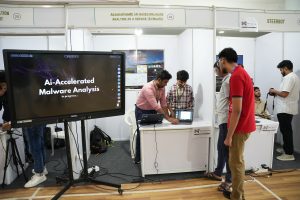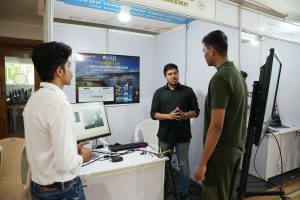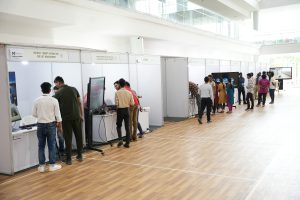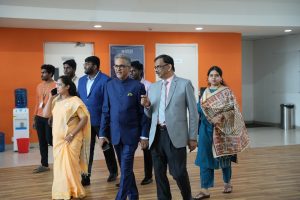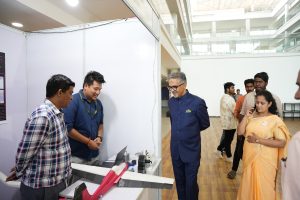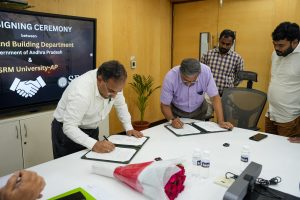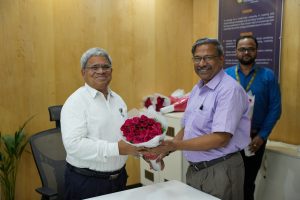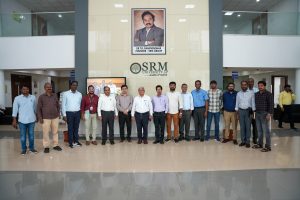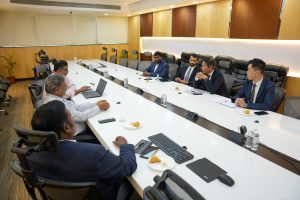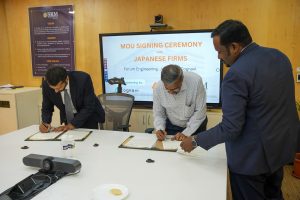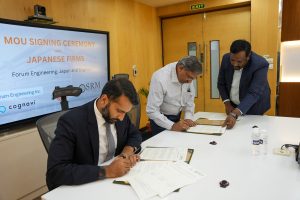Techpreneur Expo-2024: A Grand Showcase of Innovation and Technology
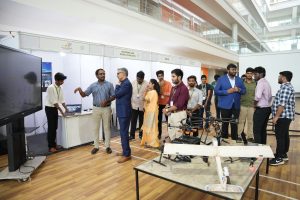 In a significant step forward for innovation and entrepreneurship, the Directorate of Entrepreneurship and Innovation recently organised the highly anticipated Techpreneur Expo-2024. The event, held at SRM University-AP, attracted a host of distinguished guests, including Dr Krish Gopalakrishnan, Co-Founder of Infosys; Mr Rohit Kapoor, CEO of Swiggy; Pro-Chancellor of SRM University-AP, Dr P Sathyanarayanan; Vice Chancellor Prof. Manoj Arora; and Registrar Dr R Premkumar, who lent their support and expertise to this integral gathering.
In a significant step forward for innovation and entrepreneurship, the Directorate of Entrepreneurship and Innovation recently organised the highly anticipated Techpreneur Expo-2024. The event, held at SRM University-AP, attracted a host of distinguished guests, including Dr Krish Gopalakrishnan, Co-Founder of Infosys; Mr Rohit Kapoor, CEO of Swiggy; Pro-Chancellor of SRM University-AP, Dr P Sathyanarayanan; Vice Chancellor Prof. Manoj Arora; and Registrar Dr R Premkumar, who lent their support and expertise to this integral gathering.
The Techpreneur Expo served as a vibrant technical showcase featuring 25 stalls presented by the Department of Next Tech Lab, the Directorate of Entrepreneurship and Innovation, and the Department of Research. Attendees were treated to an impressive array of cutting-edge technologies and projects, ranging from Additive Manufacturing and Bio-Printing to advancements in Robotics and Piezoceramics. Noteworthy projects included Unmanned Aerial Vehicles, IoT applications in Drone Technology, and pioneering RF Frontend Designs for 6G Applications. Environmental sustainability was emphasised through displays on Flexible Solid-State Electrolytes for eco-friendly lithium-ion batteries and the Responsible Management of Electronic Waste, along with initiatives for the Reclamation of Critical Metals aimed at fostering Sustainable Development.
In addition to these advanced technologies, the expo presented innovative projects such as Rechargeable Batteries, Smart Indoor Localization, and Edge AI. Guests and participants had the opportunity to explore the Thermal Management of Electronic Components, Hydrogen Fuel Cells, and Waste Valorization projects that advocate for sustainability. Cutting-edge companies, including SYNC-HAB, SecEn Semiconductors & Test Solutions, and Shakti Photon Solutions Private Limited, showcased their contributions to technology solutions. Moreover, unique offerings like Smart Automation and Self-Optimised Clean Energy Systems, No Wait (a smart solution for lift management), and AI-driven initiatives like ResuMatch for resume mock interviews and AdamantiumRE for malware analysis highlighted the inventive spirit of the event.
Throughout the expo, the esteemed guests visited each stall, commending the quality of the displays and the depth of innovation demonstrated by the students. The event proved to be a resounding success, providing invaluable insights and learning opportunities for students while fostering an atmosphere of collaboration and entrepreneurial spirit within the tech community.
The Techpreneur Expo-2024 not only spotlighted the remarkable talents of budding entrepreneurs and innovators but also set the stage for future advancements in technology, signalling a bright horizon for entrepreneurship and innovation in the region.
- Published in CR&CS Webinars, Departmental News, IDEA NEWS, Innovation, News
SRM AP Forges Partnership for Pavement Engineering
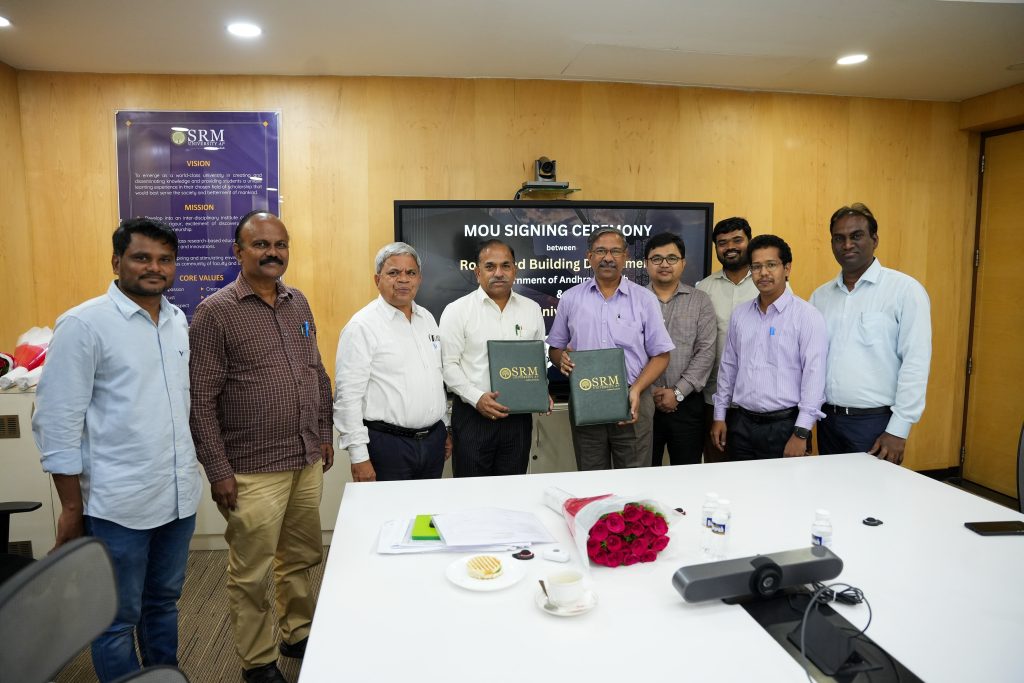
In a historic event, SRM University-AP and the Department of Road and Buildings (R&B), Government of Andhra Pradesh, signed a Memorandum of Understanding. The MoU was signed for Research, Academic and Scientific Knowledge Exchange in the field of Pavement Engineering and its allied areas.
The signing ceremony was formally executed by Dr R Premkumar, Registrar of SRM University-AP, and Sri L Srinivasa Reddy, Chief Engineer (Roads & Buildings) SH&MD, Andhra Pradesh Road Development Corporation. This significant event was witnessed by Mr K Nayeemullah, the Engineer-in-Chief (Roads & Buildings), alongside Prof. Ranjit Thapa, the Dean of Research; Dr Raviteja KVNS, the Department Head; Dr GVP Bhagat Singh, Associate Professor; Dr Uma Maheswar Arepalli, Assistant Professor; and other distinguished members of the faculty.
The collaboration poised to enhance bilateral engagement in research, pilot initiatives, and capacity-building efforts, will also foster student upskilling and reskilling through seminars, workshops, symposia, guest lectures, and co-mentorship in academic endeavours and enable them to perform better on the industrial front.
Speaking on the occasion, Registrar Dr R Premkumar stated, “This MoU serves one of the university’s goals, wherein we concentrate on positioning the university as a globally connected and regionally transformative institution of excellence.” He added that nobody is better suited than the faculty and students of SRM AP to come up with effective and affordable solutions to the problems we ourselves encounter.
“The MoU offers manifold benefits, it will enable government engineers to come and train the students and will provide them with first-hand experience in solving problems that are regional to this place”, said Mr K Nayeemullah, Engineer-in-Chief (R&B).
Dr Uma Maheswar Arepalli, Assistant Professor at the Department of Civil Engineering, SRM AP, in his statement, mentioned that the university is actively engaged in implementing the pilot study programme focused on researching cost-effective technology solutions aimed at addressing the issue of potholes across the state of Andhra Pradesh. He further stated that their team is in the process of organising a workshop aimed at raising awareness and fostering discussions on innovative approaches to infrastructure maintenance and improvement.
The MoU also aims to complement the varsity in its research endeavours by performing pilot studies and exploring new technologies including laboratory and field investigations. “The MoU will help actualise the concept of Atmanirbhar Bharat, which will only succeed if universities like SRM AP commit to providing cost-effective and real-time solutions for the betterment of society,” stated Mr Srinivasa Reddy, Chief Engineer (R&B) SH & MD APRDC.
- Published in CIVIL NEWS, Departmental News, MoU, News
SRM AP Signs MOU with Forum Engineering Inc. and Cognavi India Private Limited
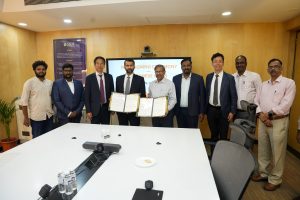 In a landmark move towards enhancing global educational opportunities, SRM University-AP has entered into a Memorandum of Understanding (MOU) with Japan’s Forum Engineering Inc. and Cognavi India Private Limited. The agreement aims to foster collaboration in providing students with career opportunities in Japan’s thriving engineering sector.
In a landmark move towards enhancing global educational opportunities, SRM University-AP has entered into a Memorandum of Understanding (MOU) with Japan’s Forum Engineering Inc. and Cognavi India Private Limited. The agreement aims to foster collaboration in providing students with career opportunities in Japan’s thriving engineering sector.
The signing ceremony, which took place at the SRM University-AP campus, brought together key representatives from all three parties. The MOU outlines a comprehensive operational framework, detailing the roles and expectations of each participant, and sets a clear roadmap for successful partnership.
As per the agreement, SRM University-AP will be responsible for identifying and providing the names and qualifications of students eligible for employment opportunities in Japan. This initiative marks a significant step in promoting international career pathways for students, particularly in engineering fields. Cognavi India will act as an intermediary, facilitating communication between SRM University-AP and Forum Engineering Inc., which will ultimately be responsible for hiring and selecting candidates for positions within its organisation.
“The collaboration with Forum Engineering Inc. and Cognavi India reflects our commitment to expanding our educational impact and providing our students with global career opportunities,” said Dr MS Vivekanandan, Director of Corporate Relations and Career Services, SRM University-AP. “We are excited about the potential of this partnership to transform the lives of our students.”
Forum Engineering Inc., based in Tokyo, is a well-established entity in the engineering sector, known for its innovative solutions and skilled workforce. The company expressed enthusiasm about the collaboration, emphasising its dedication to attracting talented graduates from SRM University-AP.
Through this partnership, we aim to bridge the gap between education and industry, creating pathways for talented individuals from India to thrive in Japan’s dynamic work environment.
Cognavi India, playing a crucial role in this partnership, will ensure that the processes of recruitment and selection are streamlined and effective, guaranteeing that both students and the partnering companies benefit from this initiative.
The MOU signifies a progressive step forward in enhancing educational collaborations between India and Japan, as well as reinforcing SRM University-AP’s position as a leading educational institution committed to student success on a global scale.
This agreement not only paves the way for students to gain valuable international experience but also fosters cultural exchanges that can lead to broader professional networks and opportunities in the future.
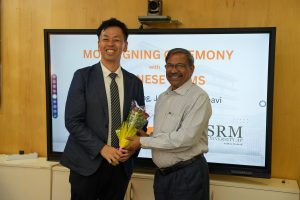
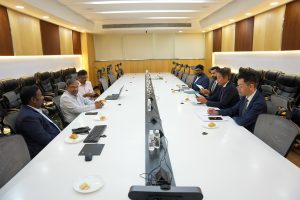
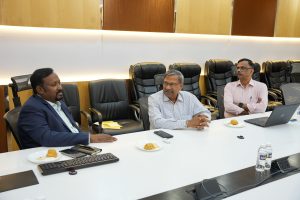
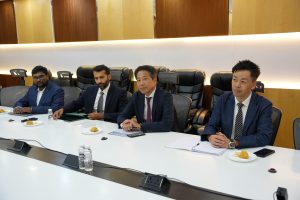

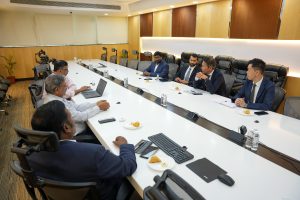
- Published in CR&CS NEWS, Departmental News, News
SMAFS Technology Gets Patented
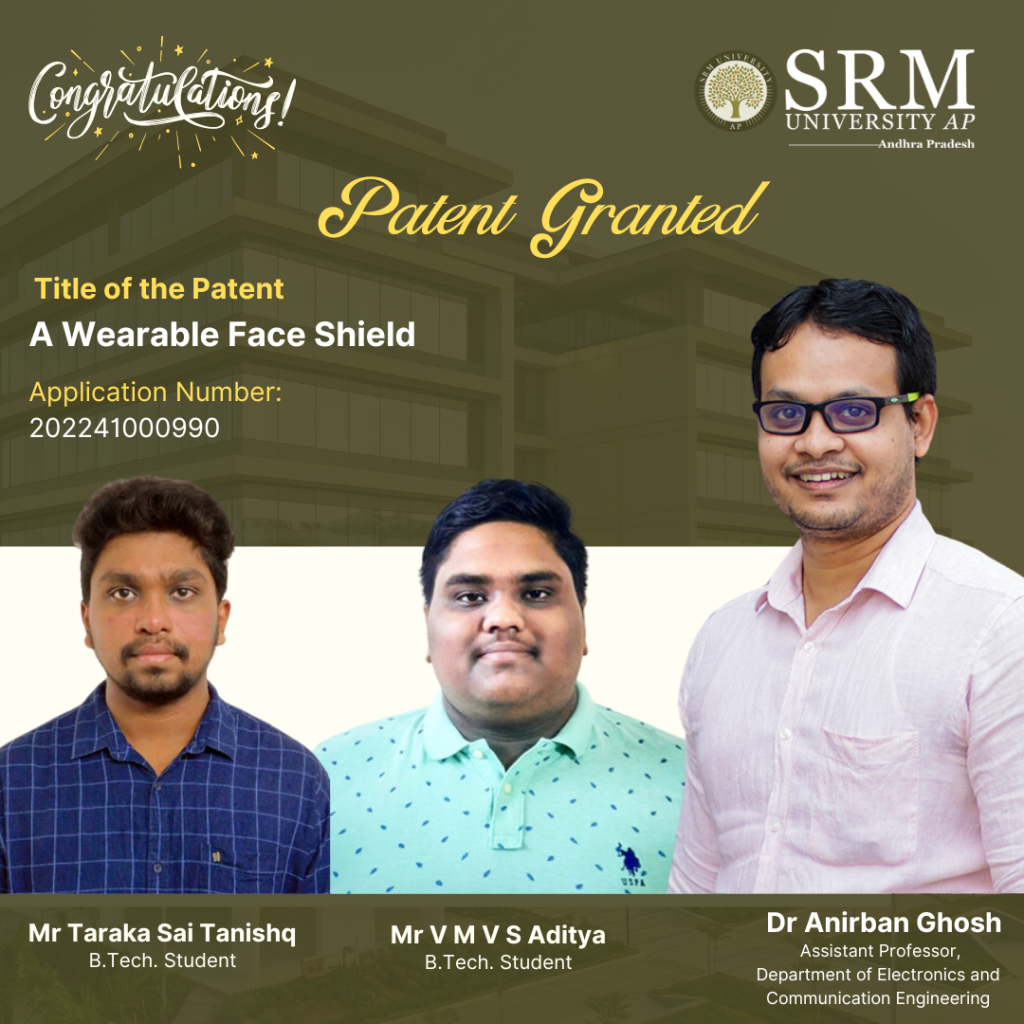
Dr Anirban Ghosh and his BTech students, Mr Taraka Sai Tanishq Chebrolu and Mr V.M.V.S. Aditya from his department, have come up with a pathbreaking innovation where a Smart Face Shield (SMAFS) helps detect a virus and reminds the wearer to maintain a safe distance. This innovation, patented under the Indian Patent Office Journal, with application number-202241000990 , marks a milestone step towards public health and safety.
Abstract:
The recent spurt of corona virus has wreaked havoc across the globe and led to huge loss of human lives. An intelligent system with innovative technologies can be implemented to address the rapid spread of the deadly virus. The wearable face shield that can not only help to maintain appropriate social distancing in a crowded place but also to identify a person with preliminary symptoms of corona virus. It is designed as a technically improved face shield to maintain social distancing by appropriate use of proximity sensor and to measure temperature of the wearer by using contact temperature sensor. LED’s and buzzer are placed strategically to alert people via visual and audio signals respectively. Such precautionary detection and proximity alert prototype can prove instrumental in early diagnosis and isolation aiding in crowd management and free movement in places of social gathering.
Practical Implementation of the Patent:
Such precautionary detection and proximity alert prototype can prove instrumental in early diagnosis and isolation aiding in crowd management and free movement in places of social gathering. Hence, wearable face shield ensures adequate separation between persons and facilitates temperature monitoring and early disease detection.
Future Research Plans:
Future research plans are to further improve the capability of the existing prototype for example integration of oxygen saturation measurement, Heartbeat, Blood pleasure, Temperature, Location, etc of the user. In the event of an emergency or critical drop in any of the vitals, the system can automatically alert the local hospital, ambulance service, and relatives.

- Published in CSE NEWS, Departmental News, ECE NEWS, News, Research News


